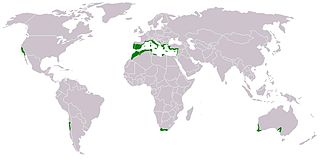
Maquis or macchia is a shrubland biome in the Mediterranean region, typically consisting of densely growing evergreen shrubs.

The common linnet is a small passerine bird of the finch family, Fringillidae. It derives its common name and the scientific name, Linaria, from its fondness for hemp seeds and flax seeds—flax being the English name of the plant from which linen is made.

Phytophthora is a genus of plant-damaging oomycetes, whose member species are capable of causing enormous economic losses on crops worldwide, as well as environmental damage in natural ecosystems. The cell wall of Phytophthora is made up of cellulose. The genus was first described by Heinrich Anton de Bary in 1875. Approximately 210 species have been described, although 100–500 undiscovered Phytophthora species are estimated to exist.

Matorral is a Spanish word, along with tomillares, for shrubland, thicket or bushes. It is used in naming and describing a Mediterranean climate ecosystem in Southern Europe.
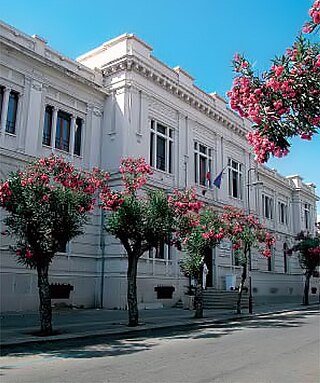
Mediterranea University of Reggio Calabria, also referred to as Mediterranea University or University of Reggio Calabria, or simply UNIRC, is an Italian public research university, located in Reggio Calabria, Italy. In 2021, it is the third best university in the state.
Cadophora malorum is a saprophytic plant pathogen that causes side rot in apple and pear and can also cause disease on asparagus and kiwifruit. C. malorum has been found parasitizing shrimp and other fungal species in the extreme environments of the Mid-Atlantic Ridge, and can be categorized as a halophilic psychrotrophic fungus and a marine fungus.

Plasmopara viticola, the causal agent of grapevine downy mildew, is a heterothallic oomycete that overwinters as oospores in leaf litter and soil. In the spring, oospores germinate to produce macrosporangia, which under wet condition release zoospores. Zoospores are splashed by rain into the canopy, where they swim to and infect through stomata. After 7–10 days, yellow lesions appear on foliage. During favorable weather the lesions sporulate and new secondary infections occur.

Apple mosaic virus (ApMV) is a plant pathogenic virus of the family Bromoviridae. It is named after its symptoms that were first present on apples. ApMV is a positive sense RNA based virus. The disease itself has several synonyms including Mild Apple Mosaic Virus, Hop Virus, Rose Mosaic Virus, and European Plum Line Patten Virus. It causes a severe yield reduction and decreased life-expectancy of fruit trees.

The American Phytopathological Society (APS) is an international scientific organization devoted to the study of plant diseases (phytopathology). APS promotes the advancement of modern concepts in the science of plant pathology and in plant health management in agricultural, urban and forest settings.

Orobanche aegyptiaca, the Egyptian broomrape, is a plant which is an obligate holoparasite from the family Orobanchaceae with a complex lifecycle. This parasite is most common in the Middle East and has a wide host range including many economically important crops.
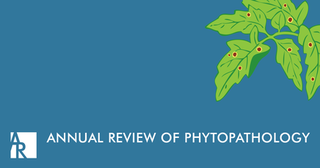
The Annual Review of Phytopathology is a peer-reviewed academic journal that publishes review articles about phytopathology, the study of diseases that affect plants. It was first published in 1963 as the result of a collaboration between the American Phytopathological Society and the nonprofit publisher Annual Reviews. As of 2022, Journal Citation Reports lists the journal's 2021 impact factor as 10.850, ranking it seventh of 238 journal titles in the category "Plant Sciences". Its current editors are Jan E. Leach and Steven E. Lindow.
Copper pesticides are copper compounds used as bactericides, algaecides, or fungicides. They can kill bacteria, oomycetes and algae, and prevent fungal spores from germinating. Common forms of fixed copper fungicides include copper sulfate, copper sulfate pentahydrate, copper hydroxide, copper oxychloride sulfate, cuprous oxide, and copper octanoate.

Schmidtea mediterranea is a freshwater triclad that lives in southern Europe and Tunisia. It is a model for regeneration, stem cells and development of tissues such as the brain and germline.

Devendra Prasad Gupta was an Indian pre-democratic political sufferer, botanist and academician.
Phaeomoniella chlamydospora is a fungus species of mitosporic ascomycota in the genus Phaeomoniella.
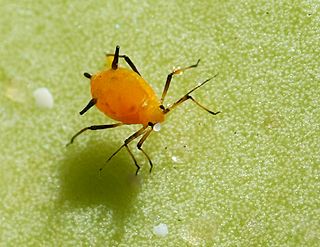
Aphis nerii is an aphid of the family Aphididae. Its common names include oleander aphid, milkweed aphid, sweet pepper aphid, and nerium aphid.

Plant Disease is a peer-reviewed scientific journal of plant pathology focusing on new diseases, epidemics, and methods of disease control. It is a continuation of The Plant Disease Bulletin (1917–1922) and The Plant Disease Reporter (1923–1979), both publications of the US Department of Agriculture. It is currently published by the American Phytopathological Society and edited by Mary Burrows.

Klasea pusilla, is a species in the genus Klasea. It is a native of the Eastern Mediterranean.
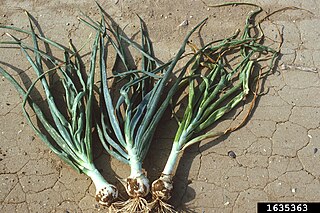
Onion yellow dwarf virus (OYDV) is a plant virus in the genus Potyvirus that has been identified worldwide and mainly infects species of Allium such as onion, garlic, and leek. The virus causes mild to severe leaf malformation, and bulb reduction up to sixty percent has been observed in garlic.
Garlic common latent virus (GarCLV) is a plant virus member of the genus Carlavirus that has been found infecting garlic globally. Detection of the virus in leek and onion has also been reported.















